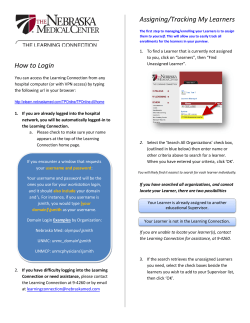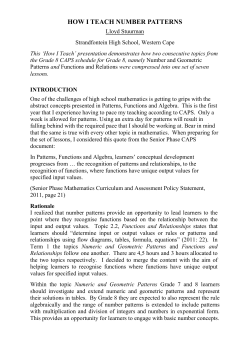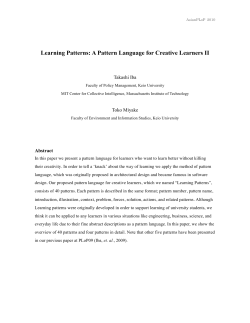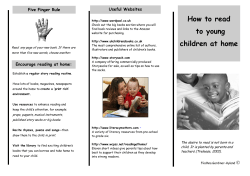
The Polyglot Project By John Fotheringham
The Polyglot Project Why Most Adult Language Learners Fail and How You Can Succeed By John Fotheringham The vast majority of language learners fail to reach fluency in their target language even after years and years of study. Most learners account their failure to one or more of the following excuses: ‣ “I’m just not good at languages.” ‣ “I had a bad language teacher.” ‣ “I don’t live where the language is spoken.” ‣ “I don’t have time to study a foreign language.” ‣ “I can’t afford language classes.” Each of these alleged reasons is in fact a fallacy: ‣ The ability to learn languages is innate and universal (except for those with mental or physical disabilities). ‣ Languages by their very nature cannot be taught, so it matters not how good or bad your teacher is. Teachers and tutors can be helpful, but the ability to learn a language well lies primarily in your court. ‣ Using readily available online and offline tools, you can learn any language anywhere in the world. Visit LanguageMastery.com for More Tips, Tools & Tech to Learn Languages the Fun Way 1 The Polyglot Project Why Most Adult Language Learners Fail and How You Can Succeed ‣ If you spend even an hour a day, every day on a language (10 minutes here, 15 minutes there) you can reach oral fluency in less than a year. ‣ You don’t need to attend formal classes to learn a language well, and in fact, the classroom is often more of a hindrance than a help as it gets people thinking about the language instead of actually spending time with the language itself. Fortunately, each of these misconceptions can be easily overcome by adopting the right language learning methods, having the right attitude toward language learning (and the target language itself), and utilizing the right materials. Methods If you have ever studied applied linguistics or T.E.S.O.L, you know that there are myriad language learning “methods” or “approaches”. All of these, however, can be distilled into two major camps: formal and natural. Formal vs. Natural Language Learning Approaches ‣ The Formal Approach. Most people’s experience learning foreign languages is of this type. It involves sitting in a classroom, studying grammar rules, memorizing vocabulary, translating to and from the foreign language, and taking lots and lots of tests. While some people do enjoy it (and enjoyment trumps all!), the formal approach to language learning has proven to be highly ineffective and inefficient for the vast majority of language learners. Visit LanguageMastery.com for More Tips, Tools & Tech to Learn Languages the Fun Way 2 The Polyglot Project Why Most Adult Language Learners Fail and How You Can Succeed ‣ The Natural Approach. This is the way all of us learned our first language and his how most successful learners acquire foreign languages. It involves getting massive quantities of listening and reading input and massive quantities of speaking output once the learner has established enough passive fluency (this usually takes about 6 months to 2 years depending on how many hours a day you spend with the language.) There is little to no attention spent on conscious study of the language’s grammar rules, and one’s abilities are measured not by tests or “levels” but by the whether or not they can actually understand and communicate in real-life situations. The Dismal Results of Formal Language Education So what are the results of teaching and learning languages in a formal, classroom-based way? Most of my experience learning and teaching languages has been in East Asia and North America, so I will use these two regions as examples: ‣ East Asia: After 10 years of English study, the vast majority of Taiwanese, Chinese, Japanese, and Korean students graduate from university unable to speak the language fluently, if at all. ‣ North America: And if you think this is just because East Asian students of English lack the proper environment, consider the case of New Brunswick, the only constitutionally bilingual province in Canada. To help boost the French skills of Anglophone citizens, the province created an early immersion program starting in the 1st grade. After 12 years of daily study, and living in a French-speaking region, only 0.68% of the students reached an intermediate level in French! (Source: www.cbc.ca via Steve Kaufmann.) Visit LanguageMastery.com for More Tips, Tools & Tech to Learn Languages the Fun Way 3 The Polyglot Project Why Most Adult Language Learners Fail and How You Can Succeed Obviously, formal language education simply doesn’t work for most people. But why? The reason is that knowledge and skills are completely different beasts. They Key Difference Between Knowledge vs. Skills Formal language education fails because it treats language as an academic subject, not the physical skill it truly is. This fact received little attention until a certain Dr. Stephen Krashen put forth his now famous Acquisition-Learning Hypothesis. This complex sounding theory can be explained with a simple metaphor: “Learning”, a conscious process, is like memorizing the owner’s manual for your new car. “Acquisition”, a sub-conscious process, is like being able to drive well (but not necessarily knowing how the car works.) Most people never reach fluency because they spend far too much time learning about the language (reading the manual) and not enough time actually acquiring it (driving the car). To learn “how to drive” in a language, you need to spend as much time as you can behind the wheel. This includes three main tasks: ‣ Listening. This is the primary task involved in acquiring a language. It is how you learned your first language and is how you will also learn your second, third, fourth, fifth, etc. When you are just starting out in a language, listen to relatively short segments over and over again until you can get the basic gist of what is being said. As your fluency expands, begin listening to longer content such as radio and TV shows, movies, etc. Many people suggest listening to music in foreign languages, but I find this to be of little help since Visit LanguageMastery.com for More Tips, Tools & Tech to Learn Languages the Fun Way 4 The Polyglot Project Why Most Adult Language Learners Fail and How You Can Succeed people don’t sing when they communicate in real-life (unless you’re trapped in a musical…) ‣ Reading. Try to find transcripts of your listening materials so you can both back up what you hear and easily look up and save new vocabulary for later review. I suggest podcasts from LingQ, Praxis (the makers of ChinesePod, SpanishPod, FrenchPod, ItalianPod and EnglishPod), and for English learners, The Get-it-done-Guy and TED Talks. Once your level permits it, buy both audio and ebook versions of your favorite books in the target language. Be careful, however, not to fall into the trap of reading more than you listen. Many learners do this, leading them to overly rely on the written word and leaving them unable to understand spoken conversations. ‣ Speaking. Once you feel ready to begin speaking (and no sooner if you can help it!), begin talking with native speakers. If you don’t live where the language is spoken, this can be accomplished easily and cheaply through Skype or Google Voice. Tutors and language partners can be found using online language learning communities like LingQ, LiveMocha, and Busuu. Why Formal Language Education Has Survived So Long So if formal language learning and teaching methods are so ineffective, why have they survived so long? There are three main reasons: ‣ The Weight of Tradition: Though there have been many “cosmetic” changes over the years, languages have been taught in the same basic way for millennia. ‣ Ignorance & Arrogance: Most people don’t know (or won’t admit) that there are better ways. Visit LanguageMastery.com for More Tips, Tools & Tech to Learn Languages the Fun Way 5 The Polyglot Project Why Most Adult Language Learners Fail and How You Can Succeed ‣ Vested Interests: Textbook publishers, language schools, teachers, and even politicians, all benefit financially from the formal education status quo. But even after we push all these factors aside, we are left with yet another obstacle: the individual learner and their attitude towards language learning and the foreign language itself. Attitude “In language learning, it is attitude, not aptitude, that determines success.” ~Steve Kaufmann, Creator of LingQ.com and author of The Way of The Linguist Mental Foundations for Success To ensure that you consistently spend enough time engaged with your target foreign language, and get the most out of whatever time you do spend, you must be: ‣ Interested. The more you like the content, the more that will stick (and the more time, in turn, that you will likely spend with the language!) ‣ Motivated. Motivation is fueled by interest, enjoyment, and perceivable progress. Which is why it is essential to choose materials you like reading or listening to. (Perceivable progress is discussed under “Patient” below.) ‣ Goal Oriented. It is not necessary to have serious, pragmatic goals, but you do need a direction to aim in. Whatever your goals, make sure that they are “SMART”: Specific, Measurable, Attainable, Realistic, and Timely. Consider these goals for example: 1) “I want to speak perfect Chinese” or 2) “I want to finish this Chinese comic book by Sunday.” Visit LanguageMastery.com for More Tips, Tools & Tech to Learn Languages the Fun Way 6 The Polyglot Project Why Most Adult Language Learners Fail and How You Can Succeed Number 1 is not a S.M.A.R.T. goal. The word “perfect” is extremely subjective and cannot be accurately measured when it comes to language learning. If you mean, “sound exactly like a native speaker”, then it is certainly not a timely goal as this requires many years of massive language input and practice, while the ability to communicate can be reached in a matter of months. Number 2, however, is a S.M.A.R.T. goal. It is very specific, can be easily measured (your finish the book or you don’t), it’s certainly attainable if the comic is not too far beyond your ability level, it’s a reasonable objective, and the timeframe is short. ‣ Patient. Language learning isn’t hard, but it does take time. And since progress in physical skills can be hard to notice, it can really help to monitor your progress through monthly or quarterly recordings (via audio or video). I do not recommend using standardized tests or completion of “levels” to measure your progress, as both do little more than show what you’ve memorized, not what you’ve actually internalized and can put into use. ‣ Calm and collected. Try not to get frustrated when you make mistakes or people can’t understand you. Both are a natural part of learning a language, and negative emotions like fear, anxiety, anger or boredom significantly reduce one’s ability to learn (and perform) physical skills like speaking a language. So how can one remain relaxed and confident in language learning? There are 2 keys: ‣ Don’t speak until you are ready. For most adults, speaking too soon leads to anxiety, inhibition and frustration when you can’t communicate your needs, wants or thoughts. It also tends to produce “fossilized errors” in your pronunciation, grammar and vocabulary usage that are very difficult to undo later. Be a baby instead. Infants spend about 2 years actively listening before starting to speak. During this time, their brains are busy Visit LanguageMastery.com for More Tips, Tools & Tech to Learn Languages the Fun Way 7 The Polyglot Project Why Most Adult Language Learners Fail and How You Can Succeed subconsciously organizing what they hear. If you want to learn a foreign language well, you should go through a similar “silent period”. ‣ When you are ready, speak as much as possible. If you don’t have any friends or colleagues who are native speakers of your target language, find a good tutor or language partner to speak with. “Good” means that they are friendly and patient, can speak a foreign language themselves (so they can empathize with you), they let you choose your own materials, and they don’t try to “teach” you the language. ‣ Disciplined. Some days you will rather zone out and watch Prison Break, and spend time reading or listening to the target language. But if you only do things when you feel like it, you won’t get very far in any kind of skill-based endeavor. The good news is that you can strengthen your discipline just like a muscle. Every time you complete a task that requires discipline, the stronger you become and the easier it is to complete the next task you aren’t in the mood for. Here are 2 prime examples: 1) Not a morning person? Force yourself to wake up the instant the alarm goes off. You will then be that much more likely to study that day. 2) Trying to watch what you eat? Each time you say no to pizza or beer, it will be that much easier to say to sitting down to a nice cold glass of foreign language input. Now that we’ve covered effective methods and the necessary attitude to learn a language, let’s turn to last (and perhaps easiest) problem to fix: materials. Materials Beyond a complete lack of efficacy, the formal language learning model has 2 other major disadvantages: Visit LanguageMastery.com for More Tips, Tools & Tech to Learn Languages the Fun Way 8 The Polyglot Project Why Most Adult Language Learners Fail and How You Can Succeed ‣ It’s expensive. Textbooks, CDs and tuition can add up quickly. Many would be language learners give up because they simply can’t afford formal classes, textbooks and CD-roms. ‣ It’s location and time specific. With jobs and families, it can be really difficult to schedule formal language classes. And even if you do, chances are that more urgent commitments will arise. Fortunately, modern technology and media distribution has solved both of these problems, while providing far more engaging and personalized content to boot! Podcasts Perhaps the best example of modern media is podcasting. Apple iTunes alone has more than 100,000 free podcast series available at the click of a button, with something sure to match every interest, ability level and language. iTunes is available for PCs, Macs, iPhones, iPod Touches, and iPads. Other podcast directories include the Zune Marketplace, Podcast Pickle, and Podcast Alley. Android can use Google Listen. And with the advent of high-end portable media players, you can carry all this content around with you wherever you go. You can literally learn anything, anytime, anywhere. YouTube Another great resource for free, short, interest-specific content is YouTube. From stupid pet tricks to how-to software tutorials, there is something for every appetite. Most episodes are between 5 and 10 minutes in length, making them perfect for repetition. Visit LanguageMastery.com for More Tips, Tools & Tech to Learn Languages the Fun Way 9 The Polyglot Project Why Most Adult Language Learners Fail and How You Can Succeed Choosing Content But with such a plethora content available today, how should one choose what to listen to and read? There are 2 key criteria that your language learning materials should meet: ‣ Interesting. Choose topics that you enjoy listening to and reading in your native language. If you are not interested in finance, then don’t waste your time on financial news in the foreign language. ‣ Comprehensible. If you can’t grasp at least 80% of the content you read or listen to, choose something easier. Most adults choose overly difficult content thinking that it will help them improve faster (and look more intelligent). In the end, this just slows progress and leaves you unmotivated to continue learning. There are two exceptions to this rule, however. ‣ In the absolute beginning, nearly all materials will be mostly incomprehensible. Once you progress from newbie to beginner, you should be able to find plenty of materials and easily apply the 80% rule. ‣ If you are really interested in the topic, it doesn’t matter as much how difficult it is. I often read business and technology magazines in Mandarin Chinese that are far beyond my ability level, but I enjoy slogging through because I enjoy the topic so much. Visit LanguageMastery.com for More Tips, Tools & Tech to Learn Languages the Fun Way 10 The Polyglot Project Why Most Adult Language Learners Fail and How You Can Succeed Conclusion If you adopt the right methods, attitudes and materials, anyone can learn a foreign language in a matter of months, not years or even decades as is usually the case with formal learning methods. Moreover, if you follow the advice above, you can actually enjoy the language learning journey, not just the destination. So download some podcasts, stick in your headphones the next time you are doing the dishes or riding the train, and do what millions of adult learners fail to do every year: learn to speak a foreign language well. “It’s too expensive” and “I don’t have time” are no longer valid excuses! Visit LanguageMastery.com for More Tips, Tools & Tech to Learn Languages the Fun Way 11
© Copyright 2025











